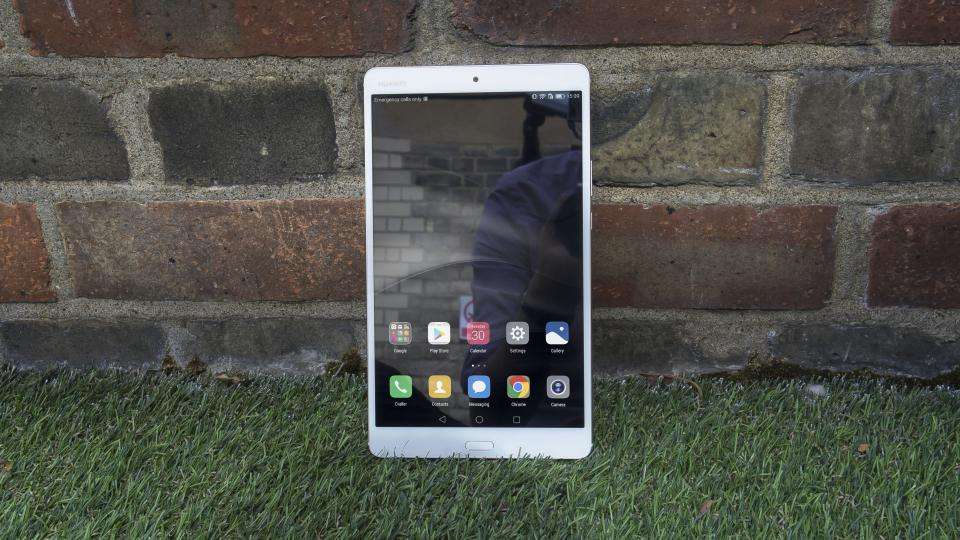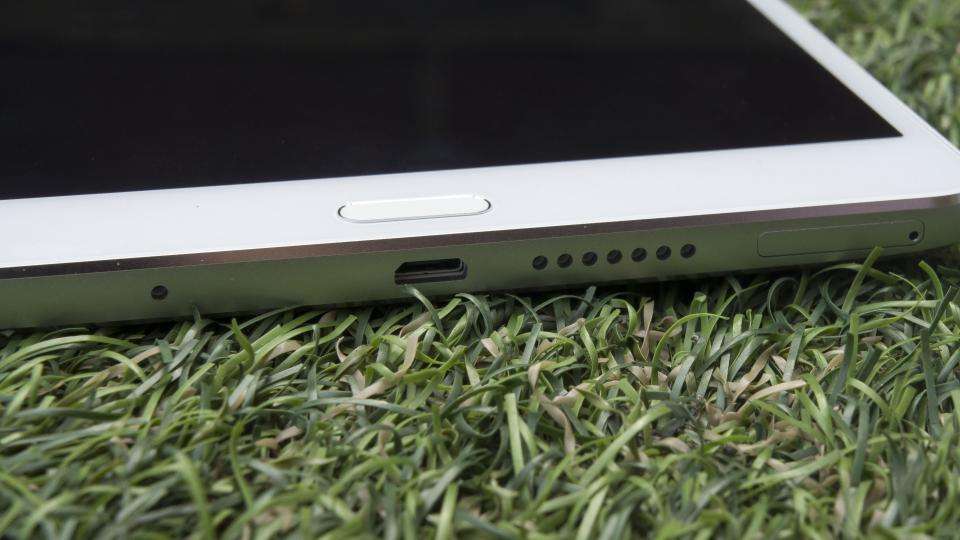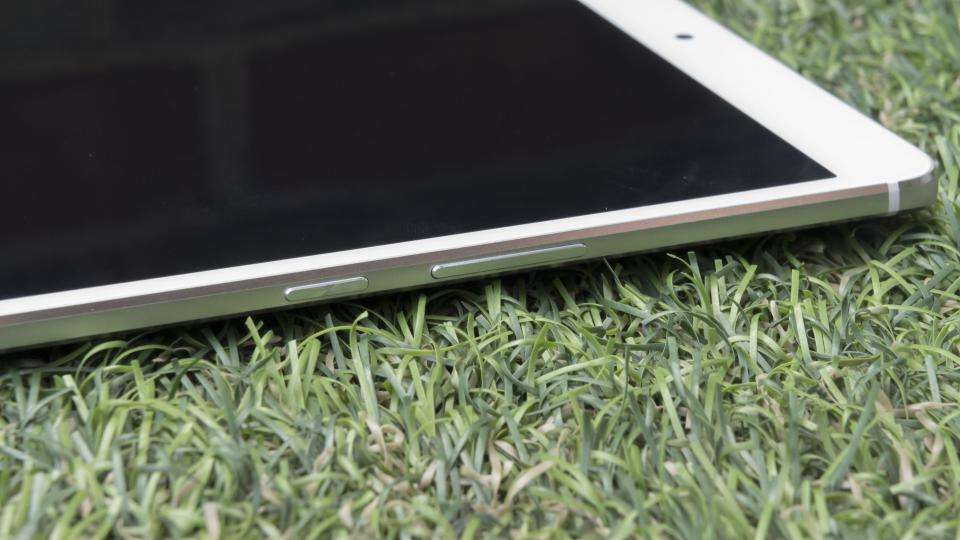Huawei is on top form, with a clutch of superlative smartphones, but the Chinese giant is frequently attempting to repeat that success with its tablet offerings. And, going by what I've seen of the MediaPad M3, the firm is dead set to snatch the premium compact tablet crown for itself.
Imagine a supersized version of Huawei’s P9 smartphone , and you're half-way there. That familiar curved metal back is complemented by subtle white detailing running across the width and sides, and while it doesn’t look dramatically different to its predecessor, the Mediapad M2 , those little design tweaks have seen it emerge looking even more handsome in 2016.
The logo has changed a touch; the speakers have shifted around a bit; and a new fingerprint reader now makes an appearance underneath the screen.
Huawei MediaPad M3 review: Display
The 8.4in 2,560 x 1,600 display will grab your attention right off the bat. It’s wonderfully bright at 420cd/m2 and with an sRGB colour gamut coverage of 94%, it’s simply oozing with bold, saturated colours – it’s great for watching movies on. Viewing angles are respectable too, and you shouldn’t have to squint too much using it outside in the British sun. The only downside? It picks up fingerprints like there’s no tomorrow, so you’d be advised to keep a cleaning cloth close to hand.
Huawei MediaPad M3 review: Camera
Huawei has equipped the MediaPad M3 with a pair of 8-megapixel cameras. There’s none of the Leica-endorsed dual-sensor trickery that made the Huawei P9 so awesome, but the MediaPad M3’s snappers are still capable of producing some pretty decent looking photographs. There was plenty of detail to our test shots, and while low light seems rather heavy-handed noise reduction smearing over fine details, this is a very respectable performance compared to its closest rivals.
Huawei MediaPad M3 review: Performance and battery life
Huawei has given the MediaPad M3 a hefty spec bump. The 1.5GHz Kirin 930 found in the M2 has been replaced by a far beefier Kirin 950 processor clocked at 2.3GHz – the same chip found in the Huawei Mate 8 . As a result, processor-heavy apps are handled with relative ease, and the tablet breezed through anything I threw at it. With a Geekbench 3 multi-core score of 5,934, it surpasses every 8in tablet we’ve tested thus far, and is the fastest compact tablet on the market right now.
For comparison sake, Apple’s iPad Mini 4 scored 3,058 and the Galaxy Tab S2 achieved a score of 4,182. With a Peacekeeper score of 1,033, web browsing speeds are theoretically well ahead of the Galaxy Tab S2, too.

As ever, though, the Kirin chips struggle a tad when it comes to graphics performance. In the GFXBench Manhattan benchmark, the MediaPad M3’s average frame rate of 6.4fps sees it lagging substantially behind the iPad Mini 4. All those extra onscreen pixels give it a bit of a headache when it comes to the most graphically intensive games such as Sky Force Reloaded, too, where it struggled noticeably, chugging along during particularly particle-rich encounters. Depending on how crucial gaming performance is for you, this may be a bit of a deal breaker.
Battery life is just a tad behind the best, too. The 5,100 mAh battery lasted just 8 hrs and 48mins in our continuous video playback test. While this should serve you well for a full work day, it isn’t all that impressive by comparison, lasting 2 hours less than the iPad Mini 4 and just over 5 hours less than the Galaxy Tab S2.
Huawei MediaPad M3 review: Ports, connections and speakers
All the essentials are present and correct. There’s the usual Micro-USB port (no, there’s no sign of USB Type-C) and 3.5mm headset jack, and if you pony up for the pricier 4G-equipped model, you also get slots for both Micro and Nano SIMs. Crucially, the on-board storage is easily expandable thanks to the presence of a microSD card slot which accepts cards of up to 128GB. The usual suspects such as 802.11ac Wi-Fi and Bluetooth 4 make the grade, too.

The speakers are a highlight. With dual Harmon Kardon certified speakers squeezed into the top and bottom edges, the M3 produces excellent sound, with oodles of volume on tap. There was a little bit of distortion at excessively high volumes but it wasn't too noticeable. The only moan is that, while the speakers are very good, they’re still not quite up to the standards of the wonderfully crisp and clear speakers found on the iPad Mini 4.
Huawei MediaPad M3 review: Verdict
The MediaPad M3 is Huawei’s compact tablet masterpiece. Not content with just taking third place behind Samsung and Apple, Huawei has built a compact tablet that is right up there with the best.
Pricing puts the M3 right up there with the priciest compacts on the market, but it’s not unreasonable. With only Euro pricing to work with currently, it looks like the M3 is going to cost around £300 for the 32GB Wi-Fi model; £350 for the 64GB Wi-Fi model; and around £350 for the 32GB LTE version. The 64GB LTE version, meanwhile, pushes the price towards £400.

The 8.4in screen is the big highlight, and if you excuse the slight dip in gaming prowess, the Kirin 950’s sheer processing oomph knocks its rivals for six. Battery life also takes a bit of a hit as a result, but if you want a powerful, compact, premium-feeling Android tablet, then the MediaPad M3 is going to take some beating.
|
Hardware |
|
Processor |
Octa-core 2.3GHz Hisilicon Kirin 950 |
|
RAM |
4GB |
|
Screen size |
8.4in |
|
Screen resolution |
2,560 x 1,600 |
|
Screen type |
IPS |
|
Front camera |
8 megapixel |
|
Rear camera |
8 megapixel |
|
Flash |
Yes |
|
GPS |
Yes |
|
Compass |
Yes |
|
Storage (free) |
32GB |
|
Memory card slot (supplied) |
Micro SD |
|
Wi-Fi |
802.11ac |
|
Bluetooth |
4.1 |
|
NFC |
No |
|
Wireless data |
4G |
|
Dimensions |
123x215x5 |
|
Weight |
320g |
|
Features |
|
Operating system |
Android 6.0 |
|
Battery size |
5,100 mAh |
|
Buying information |
|
Warranty |
|
Price |
£350 |
|
Supplier |
www.huawei.com/uk |
|
Details |
www.huawei.com/uk |
|
Part code |
BTV-DL09 |







